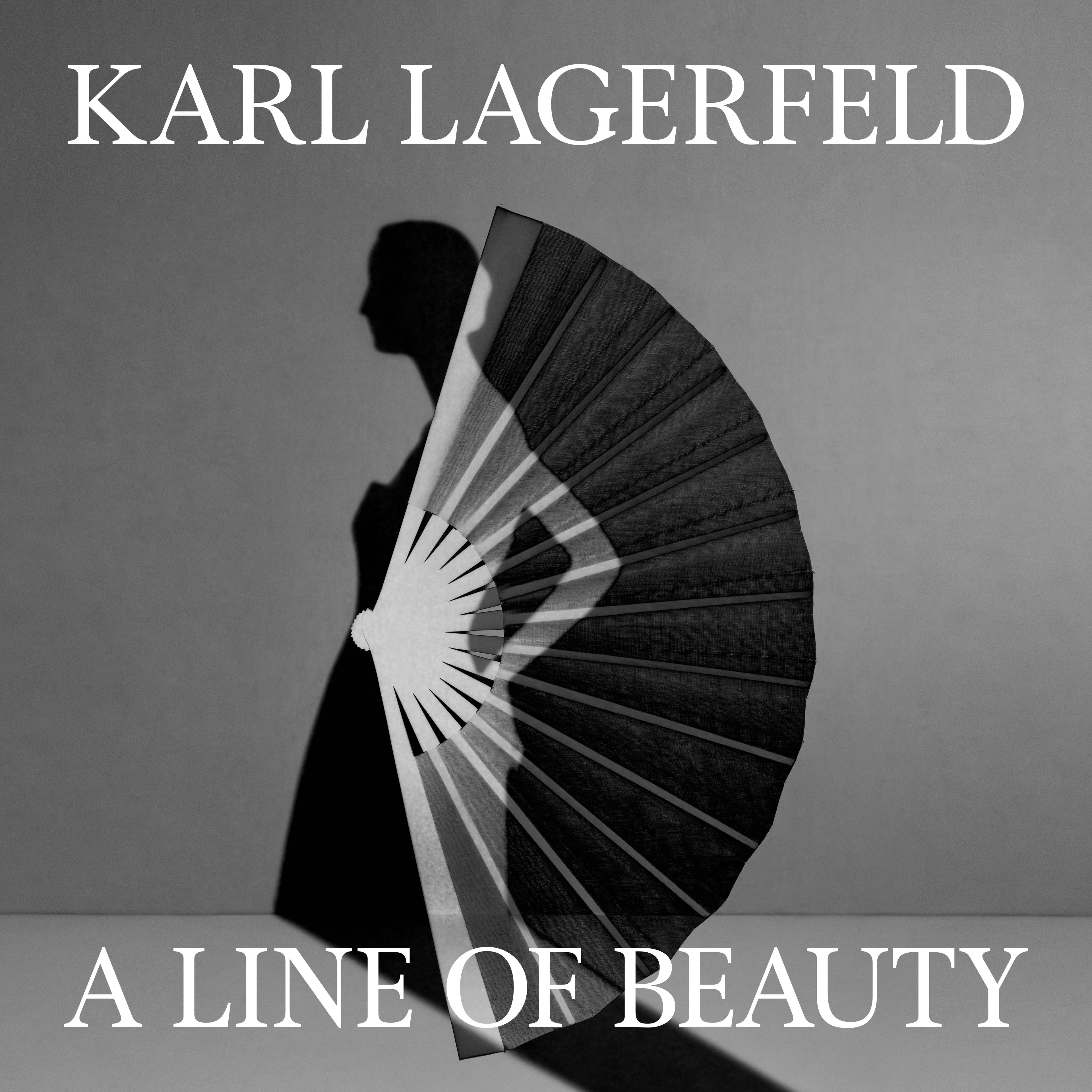Desk

The career of Karl Lagerfeld (German, 1933–2019) spanned a remarkable and incomparable sixty-five years, during which he served as the creative director of multiple design houses, including Fendi, Chloé, Chanel, and his eponymous label. Approaching fashion as both an art and a business, he created the identity of the fashion designer-impresario that has become the blueprint for contemporary designers.
While Lagerfeld the man has long been the subject of breathless mythologizing and hagiography, this exhibition focuses on Lagerfeld the designer, specifically his unique practice of sketching. Other designers draw as part of their creative process, but it is usually a means to an end rather than an end in itself as it was for Lagerfeld, whose sketches are a combination of a detailed technical drawing and an expressive fashion illustration.
Tracing the evolution of Lagerfeld’s two-dimensional drawings into three-dimensional garments, the exhibition is anchored by two lines: the “serpentine” line signifying his historicist, romantic, and decorative impulses and the “straight” line representing his modernist, classicist, and minimalist tendencies. These two lines traverse the various design houses Lagerfeld spearheaded, and the dualities inherent within them are explored in the central galleries. Presented on elevated pedestals – as totems – are garments that attempt to resolve and reconcile the competing aesthetics of these dichotomies.
The theoretical framework for the exhibition is inspired by eighteenth-century British artist William Hogarth’s concept of the “line of beauty,” an S-shaped line that represents liveliness and movement, in contrast to a straight line, which denotes stillness, inactivity, and even death. Lagerfeld, however, was much too magnanimous to hold such aesthetic judgements—for him, the serpentine and the straight line were equally beautiful, exciting, and engaging his imagination in equal measure.
Premières d’Atelier

Sketching was not only Lagerfeld’s primary mode of creative expression but 4 also his primary mode of communication. To the untrained eye, his sketches seem spontaneous and expressionistic. But to the skilled eyes of his premières d’atelier, who were responsible for translating Lagerfeld’s drawings into finished garments, they convey precise details and almost mathematical instructions. The sketches function as kind of a secret language between the designer and his collaborators, who knew exactly how to decipher every line, mark, and notation.
The premières featured in the videos in this gallery had long-established working relationships with Lagerfeld: Anita Briey, formerly of Chloé and Lagerfeld’s eponymous label; Stefania D’Alfonso of Fendi; Olivia Douchez of one of Chanel’s ateliers flou; and Jacqueline Mercier, formerly of one of Chanel’s ateliers tailleur. The interviews were conducted by the French filmmaker Loïc Prigent, who has followed and documented Lagerfeld’s collections since 1997. Each première discusses how she decoded Lagerfeld’s drawings to transform them into pieces featured in the gallery, providing valuable insights into the designer’s creative process and working methodology.
Lagerfeld was keenly aware that his reliance on the premières, whom he regarded as the architects of his vision, was reciprocal. As he explained, “When someone in the atelier has a difficult time making up one of my designs, even though I have never sewn, it is up to me to find the solution in three seconds. Otherwise, you completely lose respect in the eyes of the premières d’atelier.”
Lagerfeld was appointed the creative director of Fendi in 1965. During his tenure, he revolutionized the use of fur in fashion, treating it as if it were fabric and employing techniques traditionally associated with tailoring and dressmaking, as seen in the examples displayed here from his autumn/winter 1971–72 and 2012–13 collections. Cognizant, however, of the ethical issues surrounding the usage of fur—brought to the fore by animal rights organizations from the 1970s—Lagerfeld frequently offered alternatives that precluded the need to source new skins. For the coat from his autumn/winter 1993–94 collection, he repurposed remnants of previous designs in an early example of upcycling. His spring/summer 2013 collection included a silk dress digitally printed with a pattern that was also rendered in fur. A coat comprising thousands of strips of densely layered shredded organza that emulates the delicate pile of fur is a similarly ethically conscious simulacrum, part of the designer’s autumn/winter 2018–19 haute couture collection. Fendi has continued to expand its non-fur fashions. Additionally, new alternatives to fur and animal products continue to be explored across the fashion world—including plant-based furs, produced in response to environmental concerns surrounding the use of synthetic polymers. As Lagerfeld once remarked, “You cannot fake chic but you can be chic and fake fur.”
The International Woolmark Prize
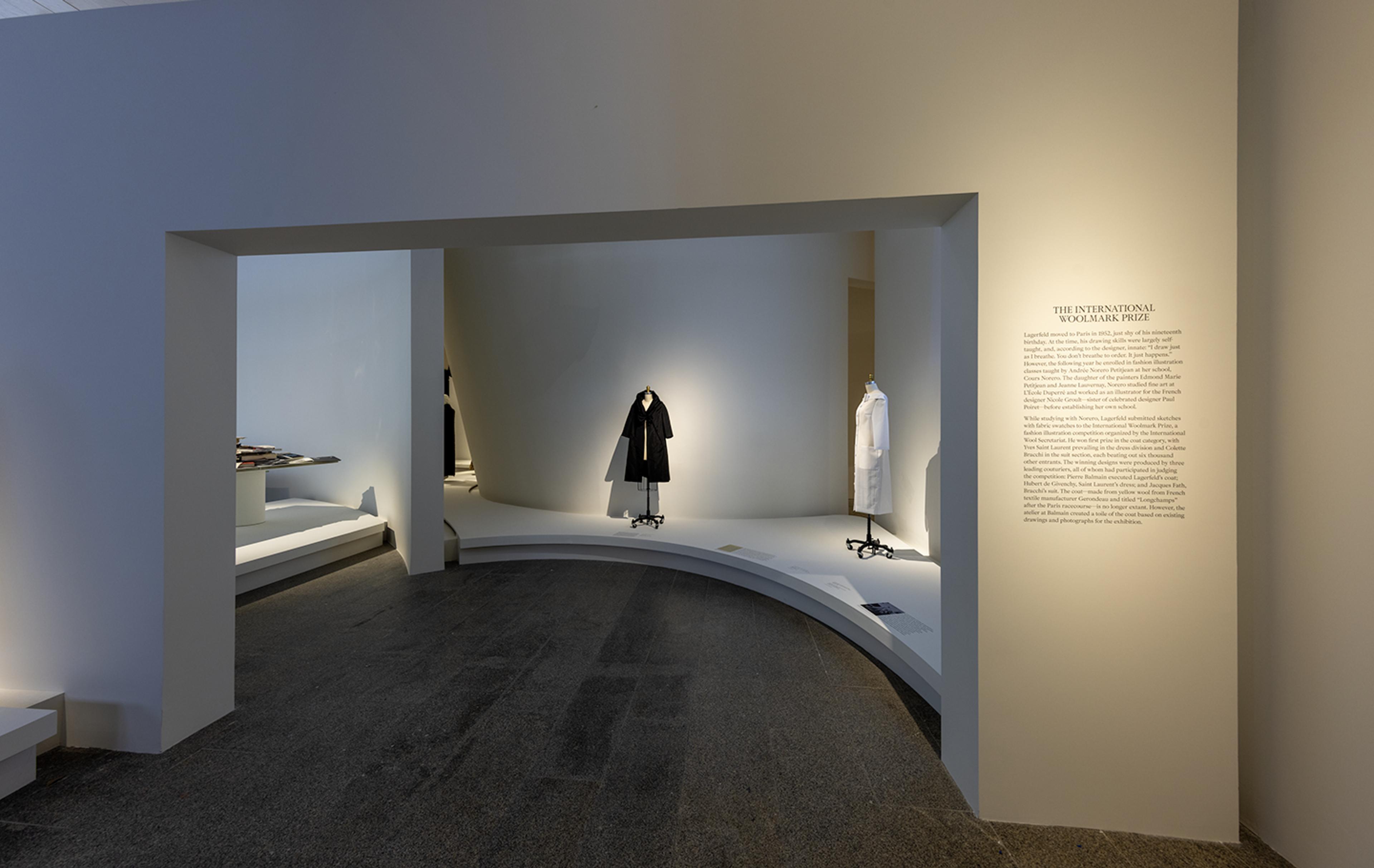
Lagerfeld moved to Paris in 1952, just shy of his nineteenth birthday. At the time, his drawing skills were largely self-taught, and, according to the designer, innate: “I draw just as I breathe. You don’t breathe to order. It just happens.” However, the following year he enrolled in fashion illustration classes taught by Andrée Norero Petitjean at her school, Cours Norero. The daughter of the painters Edmond Marie Petitjean and Jeanne Lauvernay, Norero studied fine art at L’École Duperré and worked as an illustrator for the French designer Nicole Groult—sister of celebrated designer Paul Poiret—before establishing her own school.
While studying with Norero, Lagerfeld submitted sketches with fabric swatches to the International Woolmark Prize, a fashion illustration competition organized by the International Wool Secretariat. He won first prize in the coat category, with Yves Saint Laurent prevailing in the dress division and Colette Bracchi in the suit section, each beating out six thousand other entrants. The winning designs were produced by three leading couturiers, all of whom had participated in judging the competition: Pierre Balmain executed Lagerfeld’s coat; Hubert de Givenchy, Saint Laurent’s dress; and Jacques Fath, Bracchi’s suit. The coat—made from yellow wool from French textile manufacturer Gerondeau and titled “Longchamps” after the Paris racecourse—is no longer extant. However, the atelier at Balmain created a toile of the coat based on existing drawings and photographs for the exhibition.
Following Lagerfeld’s death in 2019, scrapbooks assembled by his mother were found amid his possessions. One revealed a footnote to the designer’s lifelong habit of letter writing, an eight-page missive to his mother about the Woolmark award ceremony at the Parisian restaurant and nightclub Les Ambassadeurs. Lagerfeld recalls the events of the evening, “everything unspooling again, before [his] eyes, like a film.” He conveys his pride in his sketching abilities, his aspirations that the prize will lead to more than financial rewards, and his confidence and ease in the spotlight. Remarking on a purple velvet cravat by Pierre Cardin that he wore to the ceremony, Lagerfeld observes, “Whether it was very tasteful, I don’t know; but it was being noticed, and only that is important to me. I don’t care what people are saying. What matters first and foremost is that they are saying something at all.”
A month before winning the International Woolmark Prize in November 1954, Lagerfeld realized what was likely his first design—a wedding dress for the daughter, Christiane, of his teacher Andrée Norero Petitjean. Lagerfeld’s design was selected from among those of his fellow students at Cours Norero, in part because it could be repurposed for different occasions, an important requisite for Christiane, whose future husband was a politician. The practical elements of a top and skirt with a removable corselet and long train became leitmotifs in Lagerfeld’s later designs.
Feminine Line/Masculine Line
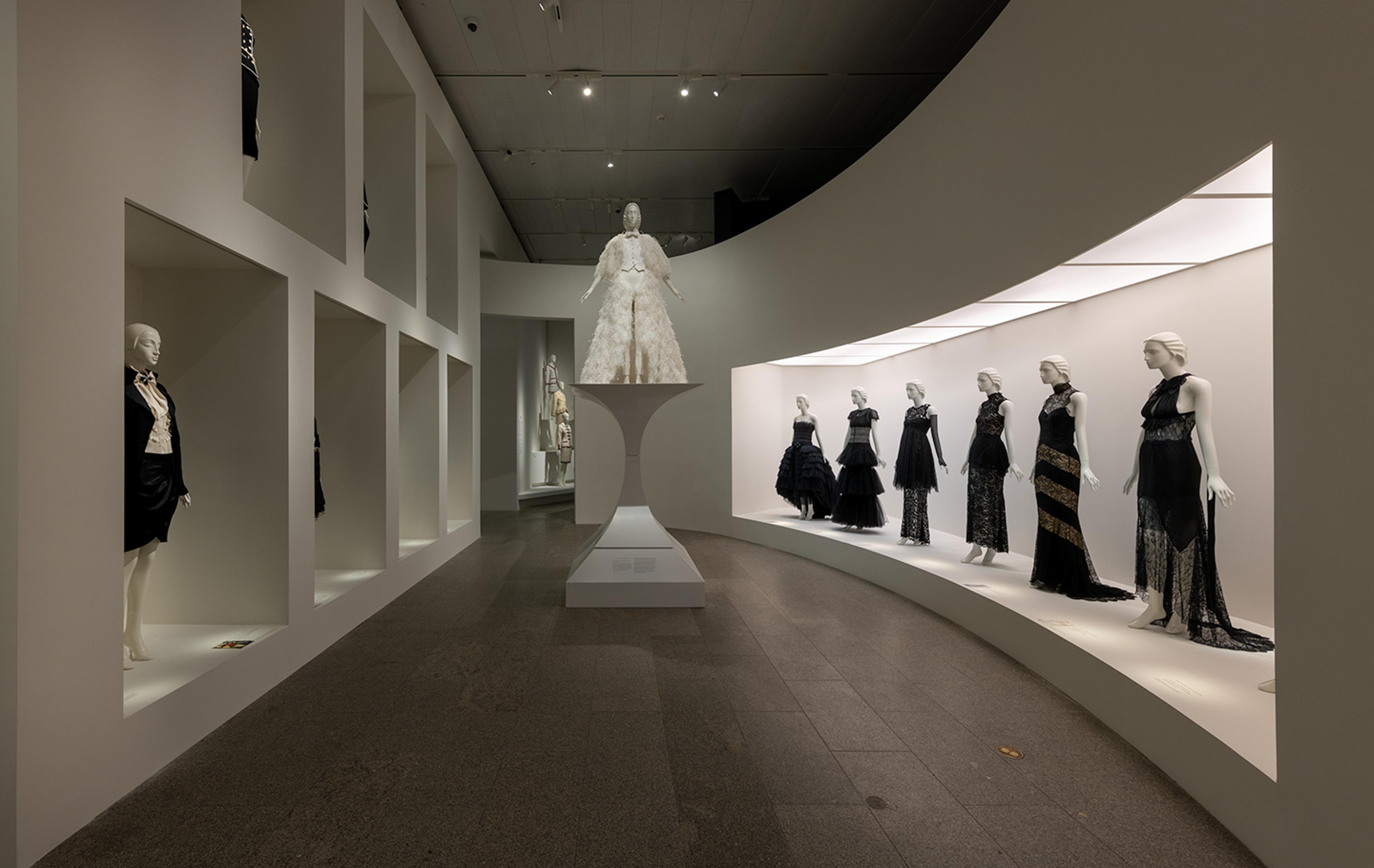
Typically, a couture house is composed of two ateliers: one devoted to the feminine art of dressmaking (flou), the other dedicated to the masculine practice of tailoring (tailleur). This classification, combined with the fashion system’s tradition of biannual menswear and womenswear prêt-à-porter, or ready-to-wear, collections, underlies the feminine/masculine dichotomy prevalent in the fashions of Lagerfeld, who not only understood but appreciated the rubrics of both the haute couture and prêt-à-porter.
The substance of dressmaking is crafting sculptural form from pliant materials, usually through draping. Across the design houses that he worked as creative director, Lagerfeld consistently employed lace, tulle, crepe, and chiffon in his articulation of supple apparel. A large part of the attraction of these materials was their propensity to reveal a garment’s structure and inner layers. This revelation and the resulting mediation between private and public presentation are manifested in the garments in the serpentine feminine line.
By contrast, the essence of tailoring is the simulation of line on the body, enabled by cutting the segments that constitute the pattern. As seen in the ensembles in the straight masculine line, tailoring is planar and relies on relatively robust materials. In his designs for Chanel and his own label in particular, Lagerfeld privileged two silhouettes: the modernist “Schlemmerian”—named after the German artist and choreographer Oskar Schlemmer—which features broad shoulders, a narrow waist, and rounded hips; and the historicist “Brummellian”—named after the Regency dandy George Bryan “Beau” Brummell—featuring an attenuated neck, short torso, and long legs.
Romantic Line/Military Line
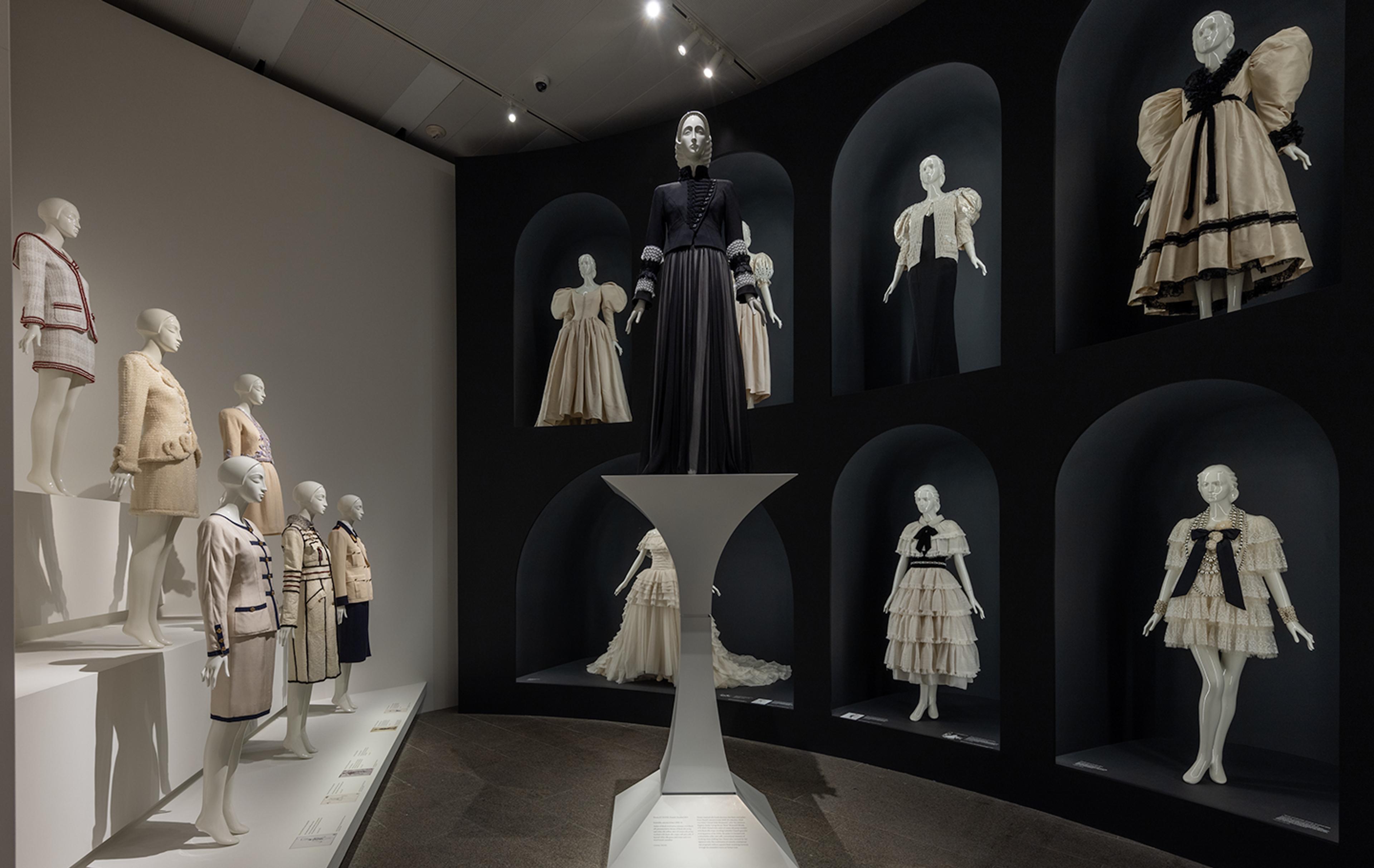
The Romantic era, beginning in Europe in the late 1700s and lasting through the 1850s, was a constant source of inspiration for Lagerfeld, particularly its idealization of nature. This pastoralism permeates the garments in the romantic line, which features both the distinctive puffed gigot, or leg-o-mutton, sleeves of the 1830s and the characteristic dome-shaped crinoline skirt of the 1850s. For the latter, Lagerfeld took inspiration from the lush, languorous paintings of Franz Xaver Winterhalter, specifically his portraits of Empress Eugénie of France and Empress Elisabeth (Sissi) of Austria—royal style icons of the Second Empire. Eugénie became so synonymous with the picturesque and overwrought resplendence of crinoline fashions that she earned the sobriquet “La Reine Crinoline.”
In Lagerfeld’s imagination, the buoyant, exuberant, and sentimental costumes of Romantic heroines existed alongside and in stark contrast with the severe, sober, and rational uniforms of military heroes. As reflected in the military line, the designer’s borrowings from war’s fiery raiment were more formal than symbolic, mostly restricted to ornamental components, such as braids inspired by hussar uniforms, tabs simulating the closures on eighteenth- and early nineteenth-century European military dress; and large pockets with scalloped flaps referencing World War I uniforms. Lagerfeld’s ingenuity extended to civilian forces, as seen in the ensemble he created with the Fendi sisters for a 1983 competition to redesign the policewomen’s uniforms in Rome.
Rococo Line/Classical Line
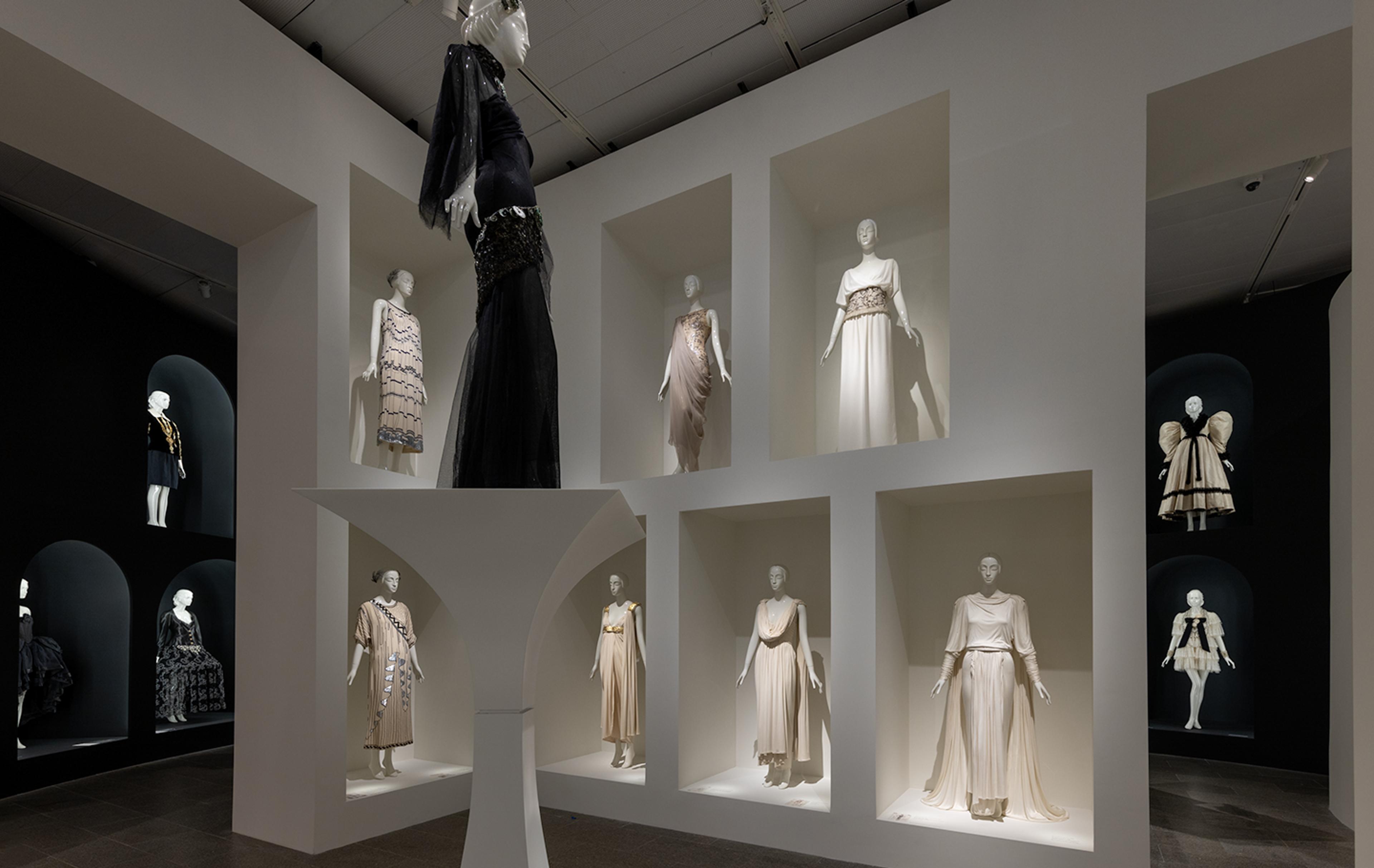
Lagerfeld’s rococo tendencies were perhaps most fully realized in his enthusiastic and often uncritical embrace of Orientalism, the historical term used to describe the fascination with and adaptation of the ideas and styles of the “East” by the “West.” Unlike the exoticizing carousels, court masques, and fêtes galantes of the eighteenth century, the Orientalist impulses of Lagerfeld were fueled by possibility rather than colorful pageantry and masquerade—namely, the potential of revisioning, reinventing, and ultimately expanding the canon of Western fashion. These possibilities largely reflected the European Orientalist imaginary, with references to the picturesque Cathay (the medieval term for China) portrayed in eighteenth-century chinoiserie decorative arts and to traditional forms of Indian dress filtered through the lens of British imperial rule.
Similarly, Lagerfeld’s classicism often referenced typical women’s apparel from ancient Greece, including the chiton, peplos, and himation. The peplos, with its distinctive overfold, or apoptygma, and brooch-like pins or fibulae at the shoulders, was the inspiration for the white silk jersey dresses Lagerfeld designed with the Fendi sisters as part of a series of costumes associated with the 1990 FIFA World Cup in Rome. Worn by dancers at the final game, the garments were accessorized with headdresses inspired by buildings and monuments from the Italian capital.
Historical Line/Futuristic Line

Lagerfeld had a shrewd and adaptable knowledge of fashion history, which he employed liberally in his designs in past/present juxtapositions in which the old informed the new and the new enlivened the old. While no time periods were off limits, the designer demanded the past be fully assimilated into the present, and only did so if it was relevant to the zeitgeist.
Lagerfeld’s promiscuous historicism was especially marked in his Chanel collections from the 1980s, a decade in which history was an active and abiding presence in the contemporary imagination under the banner of postmodernism. While he flirted with the fashions of the sixteenth century, Lagerfeld’s historical gaze was primarily directed at the dress styles of European royal courts of the seventeenth, eighteenth, and nineteenth centuries. Even his vision of the future was filtered through the lens of history, as seen in the futuristic line, which features garments inspired by the 1960s, specifically its preoccupation with space exploration fueled by Cold War aspiration and competition. The futurism of the space race and the utopian thinking it generated are captured in the ensemble from Fendi’s autumn/winter 2001–2 collection. Reminiscent of Pierre Cardin’s 1964“Cosmos” outfits, its streamlined silhouette reflected all the hope, idealism, and optimism of the new millennium.
Artisanal Line/Mechanical Line

Perhaps the most profound expression of Lagerfeld’s artistic largesse was his equal embrace of the handmade and the machine made—production processes that have traditionally defined the separation between the haute couture and the prêt-à-porter, or ready to wear. For Lagerfeld, the hand and the machine were complementary rather than contrasting tools that helped to refine, perfect, and ultimately advance his craft. However, as the fashions in this gallery demonstrate, he sometimes promoted the aesthetics of one or the other with the intention of either reinforcing or challenging the cultural meanings and hierarchical implications behind the hand/machine dichotomy, including the association of the hand with exclusivity, spontaneity, and individuality and the machine with inferiority, dehumanization, and homogenization.
The serpentine artisanal line includes garments from Lagerfeld’s haute fourrure collections for Fendi and his haute couture and métiers d’art collections for Chanel, which not only highlight but fetishize handwork by celebrating the artistry of the specialized petites mains workshops in service to dressmaking, especially those dedicated to applied decoration. In contrast, the straight mechanical line features ensembles that embrace the technical and creative potential of industrial technology, whether employed in fabric development or garment construction, such as laser cutting and selective laser sintering.
Canonical Line/Countercultural Line

One of Lagerfeld’s most enduring stylistic interests was the postmodern combination of the traditional proprieties of the couture with the transgressive provocations of the edgiest street styles. The garments in this gallery represent the dueling forces behind his gleeful confrontation between the establishment and the antiestablishment. Simultaneously asserting and enhancing their refined elegance, all the pieces in the serpentine canonical line were shown in the rarefied context of a salon, with its ambience of privacy and exclusivity. Several incorporate trompe l’oeil details that reference Gabrielle Chanel’s penchant for wearing both real and artificial jewelry, which in its day was a radical challenge to accepted notions of good and bad taste. The ensemble from Chanel’s autumn/winter 1996–97 haute couture collection represents a different simulation: the coat is made from black organza with applied strips of silk tulle that have been gathered, crocheted, and dyed to resemble a mink fur coat, the erstwhile sartorial symbol of wealth and power.
Reflective of the haute couture, the canonical line represents the “trickle-across” movement of fashions traversing horizontally between individuals of similar social and economic standing, while the countercultural line represents the “trickle-up” movement of fashions that start from the street and gravitate upward into high fashion. Lagerfeld reveled in this reversal. Sometimes his references to the street are general, focusing on items of dress that are symbolic of youthfulness, such as the miniskirt. Other times, he references specific countercultural styles such as punk, surfer, and hip hop—an affirmation of the designer’s promotion of classless fashion, fueled by his belief that true style was not to be found in the haughty reiteration of social fashion but rather in the enlightenment of fashion ideas.
Ornamental Line/Structural Line
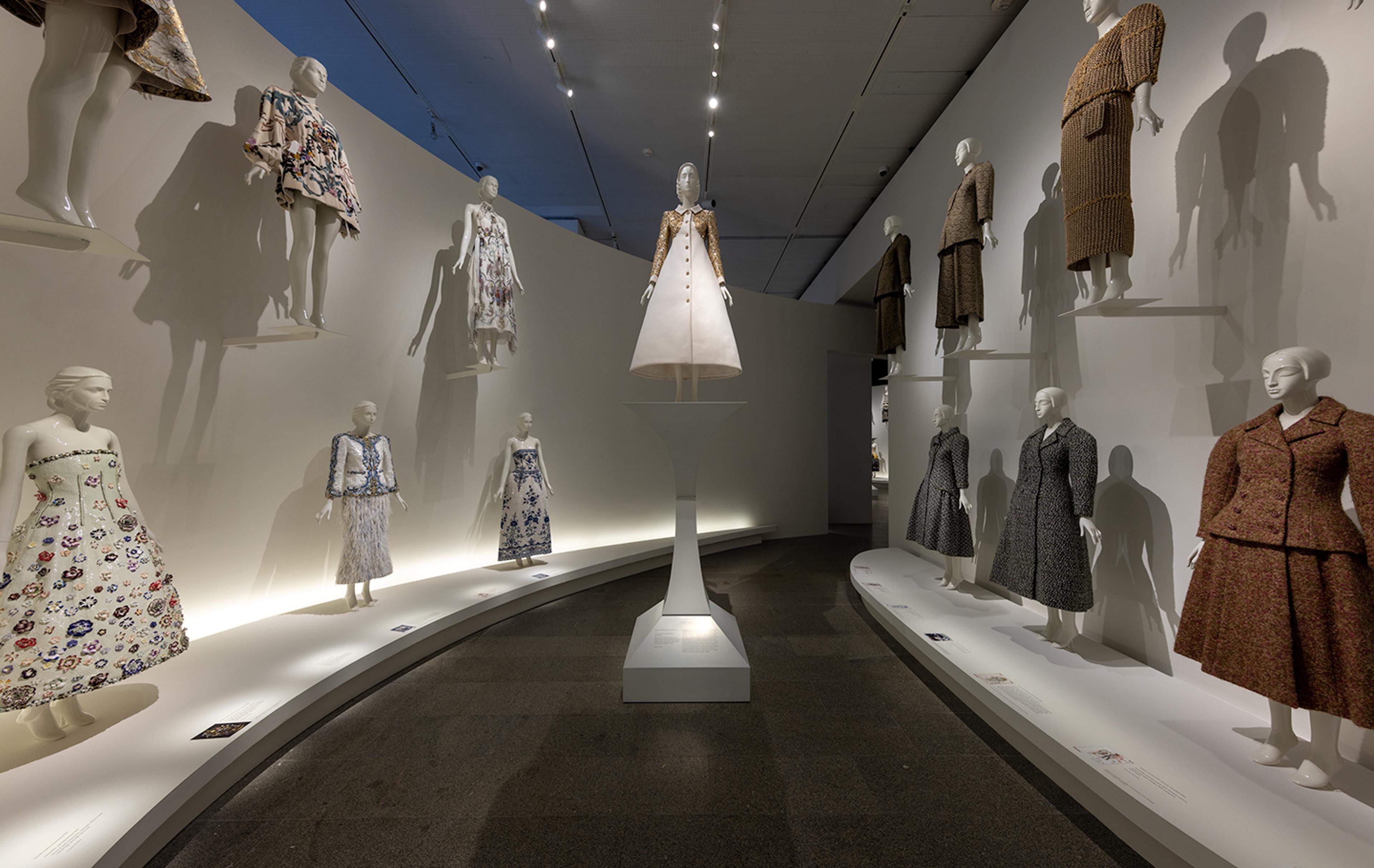
Lagerfeld was a consummate connoisseur. His collecting practices were as eclectic as his fashion inspirations and ranged from Art Deco to Memphis, Biedermeier to the Wiener Werkstätte. The designer’s greatest affinity, however, was for the arts of the eighteenth century, specifically the style of Louis XV, which he regarded as the epitome of elegance and restraint. This interest spilled over into his fashions, evident in the garments in the serpentine ornamental line, which were inspired by a diverse range of eighteenth-century decorative arts, including Jean-Baptiste Pillement’s etchings; a Meissen plate with a pierced border; Vincennes porcelain flowers; a blue-and-white lacquered corner cabinet; and a Chinese blue-and-white porcelain vase from the Qianlong period.
In contrast to the rococo flourishes of the ornamental line, the structural line reveals a modernist exactitude expressed through Lagerfeld’s approach to tailoring. Featuring a series of suits and coats from his Chanel collections, the garments reveal a fundamental difference between the designer and the founder of the house: whereas Gabrielle Chanel was chiefly interested in tailoring finishes, Lagerfeld was more concerned with tailoring construction. The fashions also highlight two of the designer’s anatomical obsessions: the shoulders and the side of the ribs—the serratus anterior, also known as the “boxer’s muscle” or, as Lagerfeld referred to it, the chute du foie, which literally translates to the “fall of the liver.”
Floral Line/Geometric Line

The floral line focuses on one of the most refined and rarefied of the couture métiers: those dedicated to the production of parurier floral, or artificial flowers. For many costume connoisseurs, artificial flowers are emblematic of the triumph of the art of fashion, and for Lagerfeld, they provided a means to simulate nature’s abundant beauty, which he exploited to its full potential by pursuing a seemingly inexhaustible plethora of botanical representations. As with his use of applied decoration more generally, the flowers that bloom on the designer’s garments are not after-the-fact decorations, but enabling principles.
In stark contrast to the organic three-dimensionality of the floral line, the geometric line includes ensembles that celebrate economy of line and two-dimensional planes. The graphic forms that appear on many of the pieces are indebted to a range of modern art movements, including Cubism, Orphism, and Constructivism. Pop Art was the inspiration for the “Alphabet” dress from the spring/summer 2004 collection of Lagerfeld’s eponymous label, which is hand painted with letters and numbers rendered in Futura, a sans-serif typeface designed by Paul Renner and released in 1927. Based on simple geometric shapes—near-perfect circles, squares, and triangles—that channel the modernity of the Bauhaus, the font epitomizes the minimalist aesthetic that underlines this grouping of garments.
Figurative Line/Abstract Line
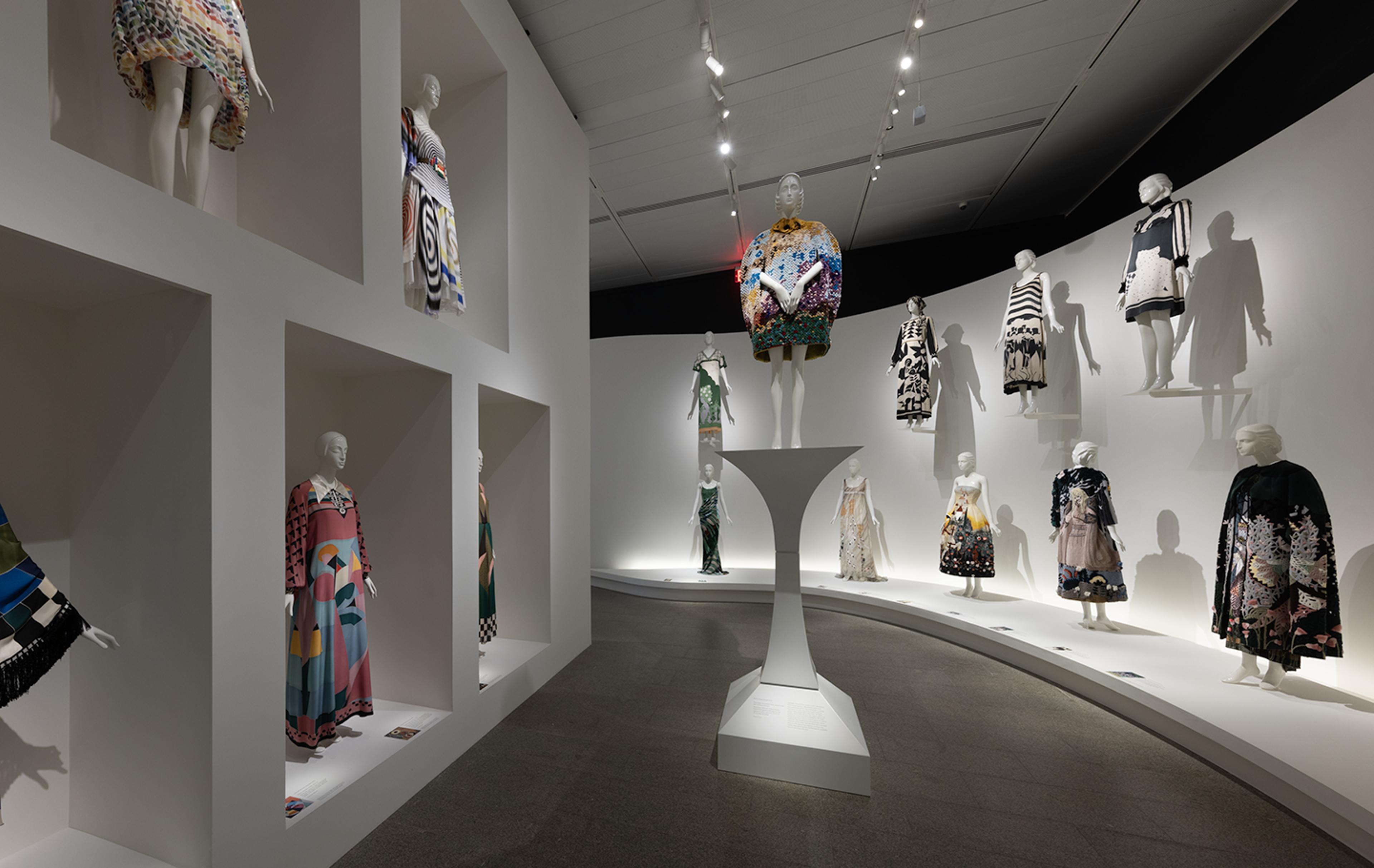
Lagerfeld felt strongly that fashion was a form of self-expression that reflected the artistic and cultural zeitgeist. He was adamant, however, that fashion was not art and that fashion designers were not artists. For Lagerfeld, fashion was irrevocably practical and commercial, comprising a system and a culture that were radically different from those of art. However, he often looked to fine art for both inspiration and information. As the figurative and abstract lines demonstrate, the designer connected art and fashion through both the narrative and non-narrative and the representational and non-representational.
Lagerfeld’s figurative tendencies were most fully expressed in his designs for Chloé and Fendi, such as the lyrical autumn/winter 2016–17 haute fourrure collection for the latter, which was inspired by Kay Nielsen’s illustrations for the 1914 book East of the Sun and West of the Moon, and for which he commissioned illustrations by Kate Baylay and Charlotte Gastaut. His designs for Chloé often drew upon Art Deco and Art Nouveau references, as in the dress from his autumn/winter 1967–68 collection that features an image inspired by British illustrator Aubrey Beardsley that was hand painted by Nicole Lefort. The French artist’s work also appears on several of the dresses in the abstract line, which expands on and develops the artistic influences seen in the previous gallery’s geometric line, with additional references to Cubism and Constructivism—art movements that held a particular fascination for Lagerfeld because, like the designer himself, their abstractions were open-minded and magnanimous.
Satirical Line
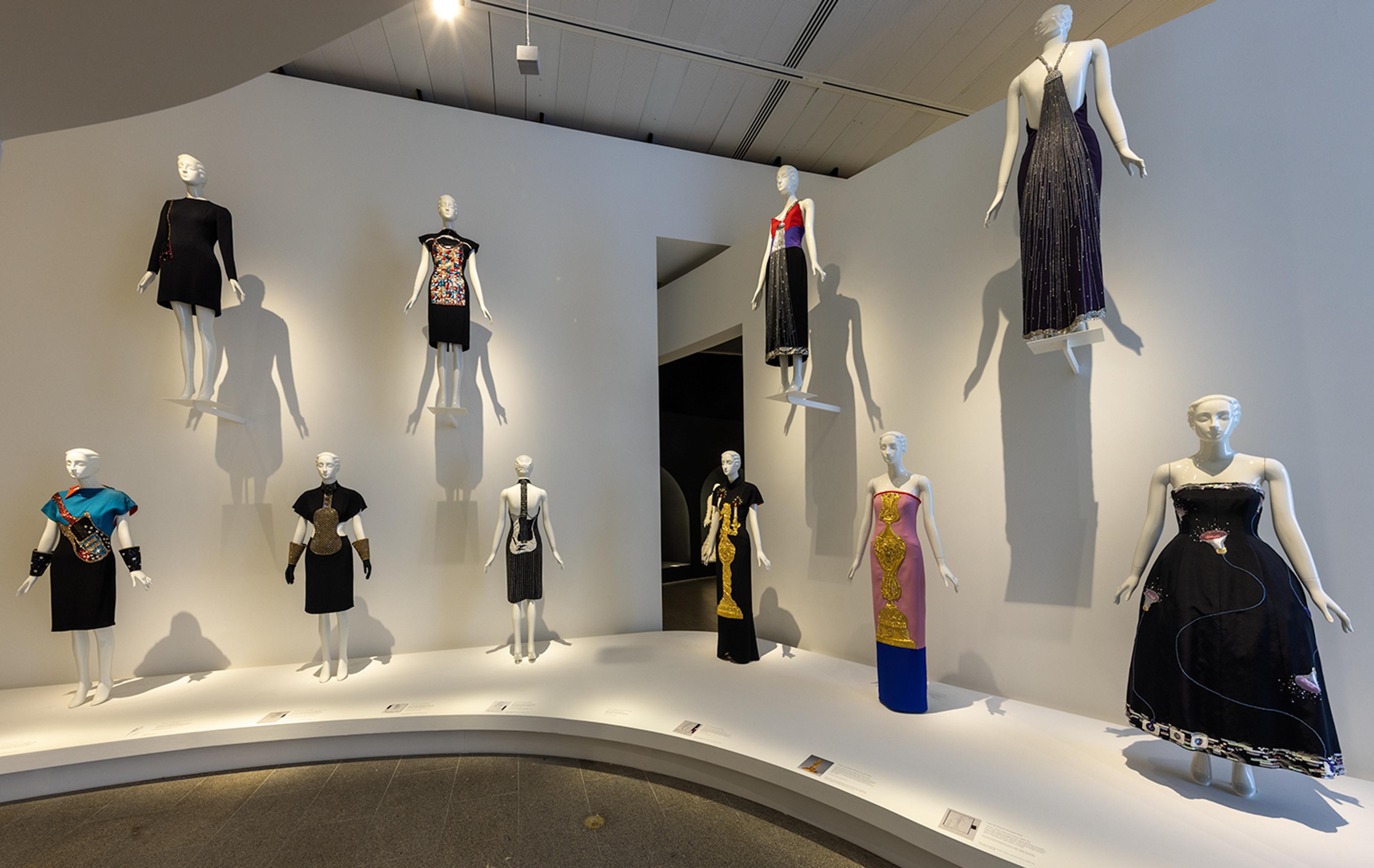
Lagerfeld took inspiration from the eighteenth century not only for his couture and collecting practices but also for his own persona, which was modeled less on aristocratic and gentlemanly archetypes and more on the Enlightenment’s definition of wit, both as an abstract concept and as a form of behavior. In his Dictionary of the English Language (1755), Samuel Johnson outlined several characteristics of wit, including novelty, imagination, judgement, and knowledge, all of which Lagerfeld embodied and reflected in his fashions. These elements appear in all the preceding galleries, but perhaps no more audaciously than in the satirical line, where they are expressed in Surrealist visual epigrams rendered in lavish embroideries.
One of Lagerfeld’s preferred Surrealist practices was trompe l’oeil, with its elision between the real and the imagined, perception and deception, demonstrable in the handbag embroidered on the Chanel dress and the sheath dress hung from a clothes hanger on the Chloé dress. Another favored technique was the democratic embrace of the commonplace, as seen in his “lightbulb” and “shower” dresses for Chloé and the “candlestick” dresses for his eponymous label—tongue-in-cheek (mis)appropriations of vernacular objects that revel in humorous displacements as well as disruptions of scale, status, and association. Through boldly inventive and beautifully executed embroideries, Lagerfeld converts the everyday into the exceptional, reconciling the ordinary and the extraordinary, the unremarkable and the remarkable.
The Puppet

After years of introspection, Lagerfeld’s self-presentation ossified into a black-and-white uniform in the early 2000s that was as identifiable as the one Gabrielle Chanel fashioned for herself in the mid-1950s. As with Chanel, Lagerfeld looked to the dandy for his self-styling, adopting the principles of rigor and restraint established by George Bryan “Beau” Brummell, the prototypical dandy of the late eighteenth and early nineteenth centuries. In classic dandy fashion, the designer’s meticulously constructed image and carefully considered words established a visual and verbal coherence that prioritized style over substance. This privileging allowed him to operate on a surface level, deflecting deeper meanings or probing analyses. “With me there’s nothing below the surface,” he was fond of saying. Ultimately, Lagerfeld’s globally recognized uniform was a cloak of invisibility, making it possible for him to hide in plain sight on the world stage.
To deepen the deceit, Lagerfeld deliberately lent himself to caricature. Channeling Andy Warhol, another dandy, Lagerfeld presented this caricature as a commercial experiment through various representations of his black-and-white look, primarily in collections for Chanel and his eponymous label. The apogee of this Warholian experiment was his 2004 collaboration with the high-street chain H&M. The thirty-piece capsule collection for men and women was limited to a black-and-white color palette and included jackets, shirts, and accessories—ties, rings, sunglasses, fingerless gloves—based on Lagerfeld’s personal wardrobe. The overwhelming success of the collection simultaneously iconized and magnified Lagerfeld’s name and image, fulfilling his infamous comment, “I am a living label. My name is Labelfeld, not Lagerfeld.”
Ellipse
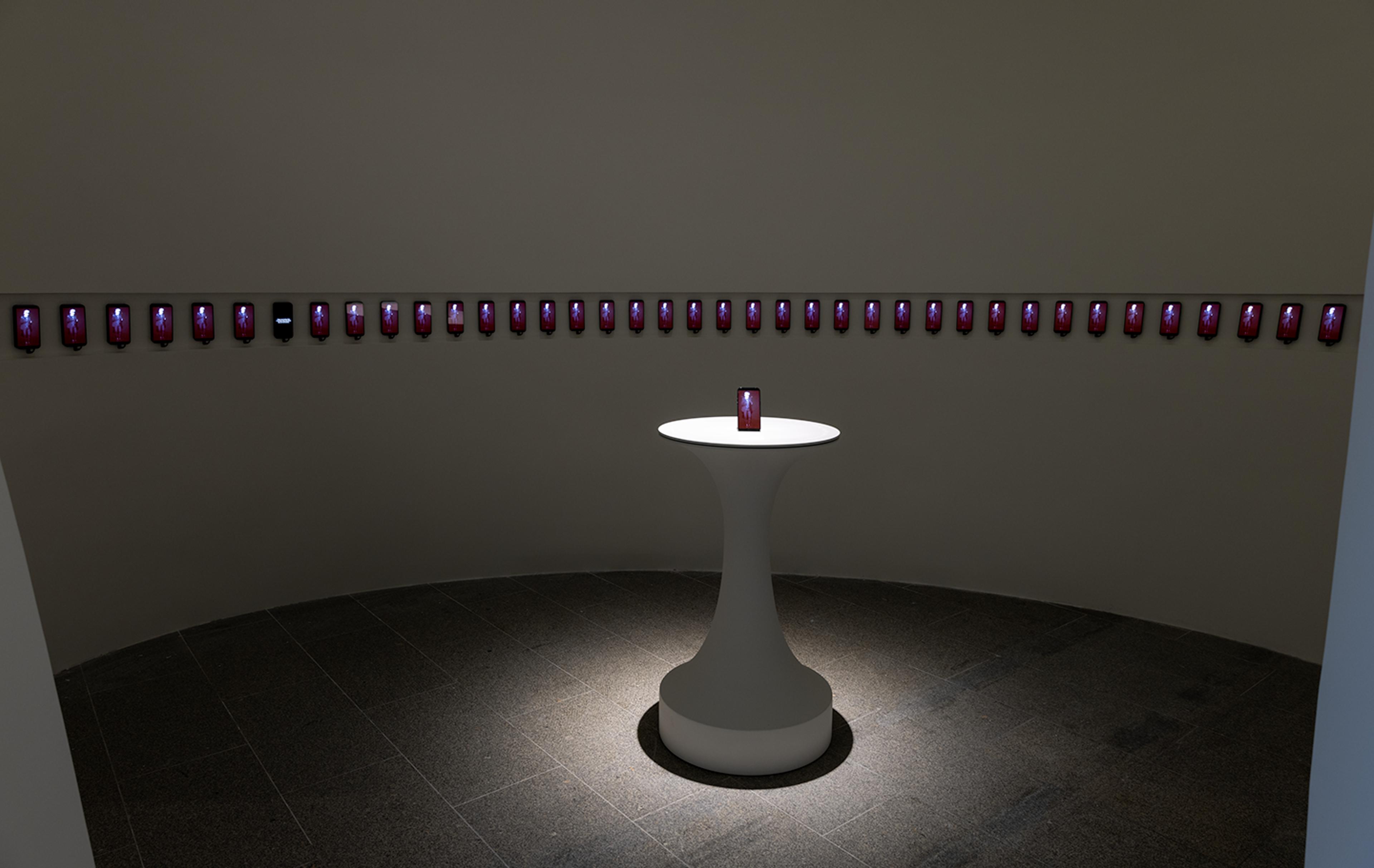
“I am three people. When I speak English, I’m one person; when I speak German, I’m another; and when I speak French, I’m somebody else again.”
This personal footage from Loïc Prigent documents an impromptu moment from 2011, when Lagerfeld was filming a special feature for the French/German television channel ARTE. A polymath and polyglot who prided himself on his communication skills, the designer is captured dissolving into laughter as he confuses his French, English, and his native German. Lagerfeld’s creative collaborators were accustomed to receiving dispatches from him in a variety of forms: by post, by fax, and, in his later years, electronically from his phone. This space embraces his literal and technological loquaciousness as well as the centrality of his phone to his creative process, presenting his epigrams, or “Karlisms,” in a dynamic installation conceived by the British director Baillie Walsh, granting Lagerfeld the final word.
Fragments of a Man
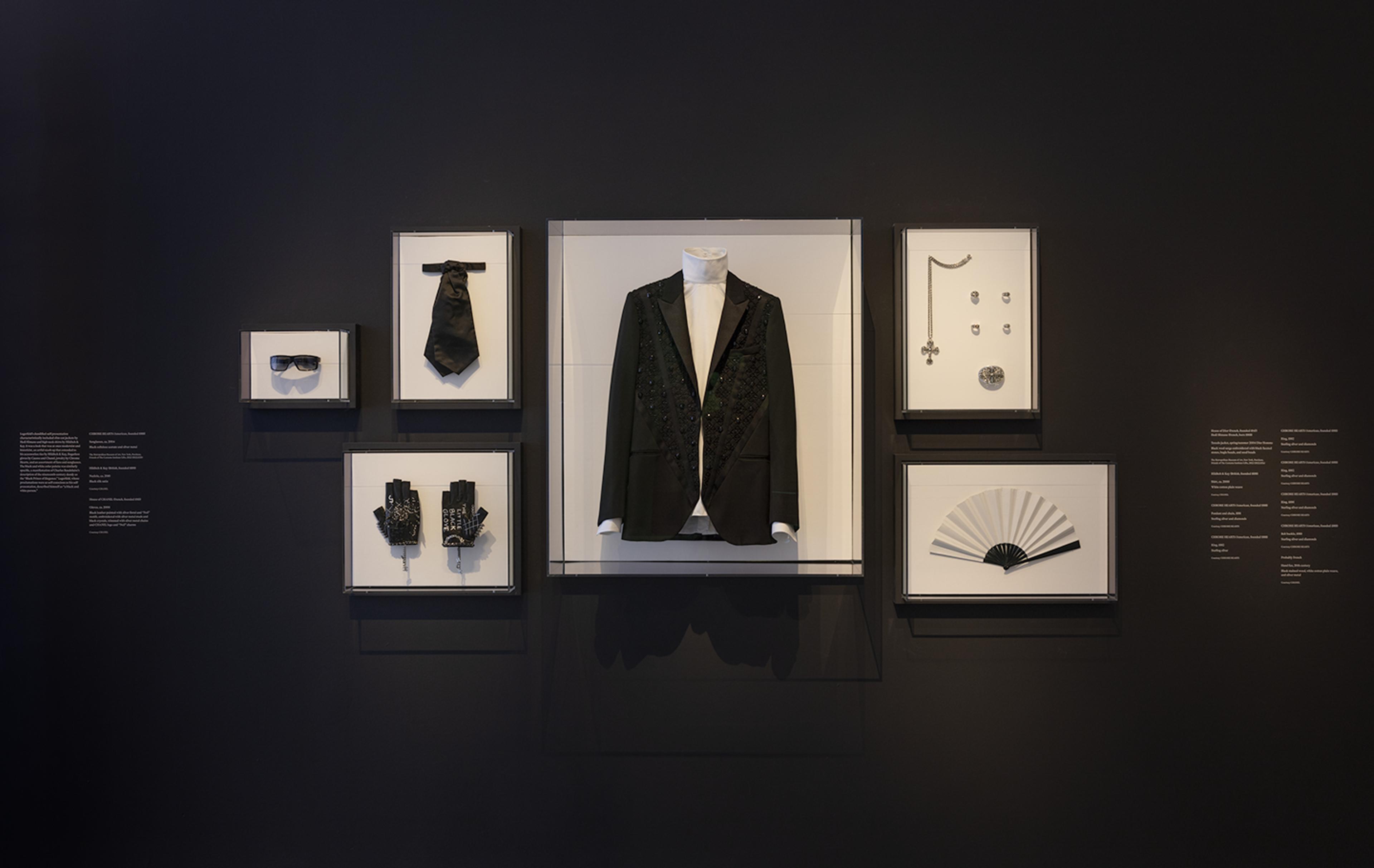
Lagerfeld’s dandified self-presentation characteristically included slim-cut jackets by Hedi Slimane and high-neck shirts by Hilditch & Key. It was a look that was at once modernist and historicist, an artful mash-up that extended to his accessories: ties by Hilditch & Key, fingerless gloves by Causse and Chanel, jewelry by Chrome Hearts, and an assortment of fans and sunglasses. The black and white color palette was similarly specific, a manifestation of Charles Baudelaire’s description of the nineteenth-century dandy as the “Black Prince of Elegance.” Lagerfeld, whose proclamations were as self-conscious as his self-presentation, described himself as “a black and white person.”
